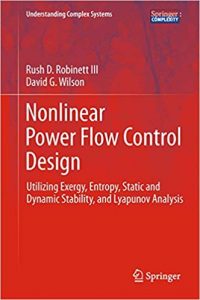نام کتاب: Nonlinear Power Flow Control Design – Utilizing Exergy, Entropy, Static And Dynamic Stability, And Lyapunov Analysis
نویسنده: Rush D. Robinett Iii و David G. Wilson
ویرایش: ۱
سال انتشار: ۲۰۱۱
کد ISBN کتاب: ۰۸۵۷۲۹۸۲۲۴, ۹۷۸۰۸۵۷۲۹۸۲۲۵
فرمت: PDF
تعداد صفحه: ۳۴۶
انتشارات: Springer-Verlag London
Description About Book Nonlinear Power Flow Control Design – Utilizing Exergy, Entropy, Static And Dynamic Stability, And Lyapunov Analysis From Amazon
Nonlinear Powerflow Control Design presents an innovative control system design process motivated by renewable energy electric grid integration problems. The concepts developed result from the convergence of three research and development goals:
• to create a unifying metric to compare the value of different energy sources – coal-burning power plant, wind turbines, solar photovoltaics, etc. – to be integrated into the electric power grid and to replace the typical metric of costs/profit;
• to develop a new nonlinear control tool that applies power flow control, thermodynamics, and complex adaptive systems theory to the energy grid in a consistent way; and
• to apply collective robotics theories to the creation of high-performance teams of people and key individuals in order to account for human factors in controlling and selling power into a distributed, decentralized electric power grid.
All three of these goals have important concepts in common: exergy flow, limit cycles, and balance between competing power flows. In place of the typical zero-sum, stability vs. performance, linear controller design process, the authors propose a unique set of criteria to design controllers for a class of nonlinear systems with respect to both performance and stability, and seamlessly integrating information theoretic concepts. A combination of thermodynamics with Hamiltonian systems provides the theoretical foundation which is then realized in a series of connected case studies. It allows the process of control design to be viewed as a power flow control problem, balancing the power flowing into a system against that being dissipated within it and dependent on the power being stored in it – an interplay between kinetic and potential energies.
Highlights of several of the case studies feature current renewable energy problems such as the future of electric power grid control, wind turbine load alleviation, and novel control designs for micro-grids that incorporate wind and sunlight as renewable energy sources. The sustainability of self-organizing systems are dealt with as advanced topics. Research scientists, practicing engineers, engineering students, and others with a background in engineering will be able to develop and apply this methodology to their particular problems.
درباره کتاب Nonlinear Power Flow Control Design – Utilizing Exergy, Entropy, Static And Dynamic Stability, And Lyapunov Analysis ترجمه شده از گوگل
غیر خطی POWERFLOW طراحی کنترل ارائه فرآیند طراحی سیستم کنترل نوآورانه با انگیزه های انرژی تجدید پذیر مشکلات ادغام شبکه برق. مفاهیم نتیجه توسعه یافته از همگرایی سه گل در تحقیق و توسعه:
• برای ایجاد یک وحدت متریک به مقایسه ارزش منابع مختلف انرژی – نیروگاه های زغال سوز، توربین های بادی، فتوولتائیک خورشیدی، و غیره – به به شبکه برق توان یکپارچه و به جای متریک نمونه ای از هزینه / سود؛
• به منظور توسعه یک ابزار جدید کنترل غیر خطی است که کنترل قدرت جریان، ترمودینامیک، و نظریه سیستمهای انطباقی پیچیده به شبکه انرژی در راه سازگار صادق است. و
• برای کاربرد نظریات رباتیک جمعی به ایجاد تیم های با عملکرد بالا از مردم و افراد کلیدی به منظور حساب کاربری برای عوامل انسانی در کنترل و فروش قدرت را به یک توزیع شده، غیر متمرکز شبکه برق.
هر سه این اهداف مفاهیم مهم مشترک هستند: جریان اگزرژی، چرخه حد، و تعادل بین قدرت رقابت جریان می یابد. به جای جمع صفر، عملکرد در مقابل پایداری، طراحی کنترل خطی معمولی، نویسندهپیشنهاد مجموعه ای منحصر به فرد از معیارهای طراحی کنترل کننده برای یک کلاس از سیستم های غیر خطی با توجه به هر دو عملکرد و ثبات، و اطلاعات یکپارچه یکپارچه سازی مفاهیم نظری . ترکیبی از ترمودینامیک با سیستم های هامیلتونی پایه نظری است که پس از آن در یک سری از مطالعات موردی متصل متوجه فراهم می کند. این اجازه می دهد فرایند طراحی کنترل را به عنوان یک مشکل کنترل جریان قدرت مشاهده می شود، حفظ تعادل قدرت جریان را به یک سیستم در برابر آن و داخل آن از بین می رود و وابسته به قدرت در آن ذخیره می شود – فعل و انفعال بین انرژی های جنبشی و پتانسیل.
نکات برجسته از چند از مطالعات موردی از ویژگی های مشکلات انرژی های تجدید پذیر در حال حاضر مانند در آینده از قدرت کنترل الکتریکی شبکه، توربین بادی کاهش بار، و طرح های کنترل جدید برای میکرو شبکه که باد ترکیب و نور خورشید به عنوان منابع انرژی تجدید پذیر. پایداری این سیستم خود سازمان با عنوان مباحث پیشرفته پرداخته است. تحقیقات دانشمندان، مهندسان تمرین، دانشجویان، مهندسی، و دیگران را با یک پس زمینه در مهندسی قادر به توسعه و به کار بردن این روش برای مشکلات خاص خود را خواهد داشت.
[box type=”info”]![]() جهت دسترسی به توضیحات این کتاب در Amazon اینجا کلیک کنید.
جهت دسترسی به توضیحات این کتاب در Amazon اینجا کلیک کنید.![]() در صورت خراب بودن لینک کتاب، در قسمت نظرات همین مطلب گزارش دهید.
در صورت خراب بودن لینک کتاب، در قسمت نظرات همین مطلب گزارش دهید.

